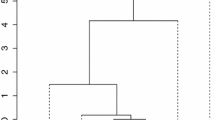Abstract
If a geochemical compositional dataset X (n×p)is a realization of a physical mixing process, then each of its sample (row) vectors will approximately be a convex combination (mixture) of a fixed set of (l×p)extreme compositions termed endmembers. The kpoints in p-space corresponding to a specified set of k (k<p)linearly independent endmember estimates associated with a p-variate (n×p)compositional dataset X,define the vertices of a (k−1)dimensional simplex H.The nestimated mixtures X′ (n×p)which together account for the systematic variation in the dataset X,should each be convex combinations of the kfixed endmember estimates. Accordingly,the npoints in p-space which represent these mixtures should be interior points of the simplex H.Otherwise, for each sample point which lies outside H,at least one of the mixture coefficients (endmember contributions) will be negative. The purpose of this paper is to describe procedures for expanding H in the situation that its vertices are not a set of extreme points for the set which represents the mixtures.
Similar content being viewed by others
References
Aitchison, J., 1986, The statistical analysis of compositional data: Chapman and Hall, London and New York, 416 p.
Dymond, J., Lyle, M., Finney, B., Piper, D. Z.. Murphy, K., Conard, R., and Pisias, N., 1984, Ferromanganese nodules from MOANOP sites H, S, and R—Control of mineralogical and chemical composition by multiple accretionary processes: Geochimica et Cosmochimica Acta, v. 48, no. 5, p. 931–949.
Ehrlich, R., and Full, W. E., 1987, Sorting out geology—unmixing mixtures,in Size, W. B., ed., Use and abuse of statistical methods in the earth sciences: Intern. Assoc. Math. Geology Studies in Math. Geology No. 1, Oxford Univ. Press, New York and Oxford, p. 33–46.
Full, W. E., Ehrlich, R., and Bezdek, J. C., 1982, FUZZY QMODEL-a new approach for linear unmixing: Math. Geology, v. 14, no. 3, p. 259–270.
Full, W. E., Ehrlich, R., and Klovan, J. E., 1981, EXTENDED QMODEL—Objective definition of external endmembers in the analysis of mixtures: Math. Geology, v. 13, no. 4, p. 331–344.
Imbrie, J., and Van Andel, T. H., 1964, Vector analysis of heavy-mineral data: Geol. Soc. America Bull., v. 75, no. 11, p. 1131–1156.
Klovan, J. E., and Imbrie, J., 1971, An algorithm and FORTRAN IV program for large-scale Q-Mode factor analysis and calculation of factor scores: Math. Geology, v. 3, no. 1, p. 61–76.
Klovan, J. E., and Miesch, A. T., 1976, EXTENDED CABFAC and QMODEL computer programs for Q-Mode factor analysis of compositional data: Computers & Geosciences, v. 1, no. 3, p. 161–178.
Miesch, A. T., 1976a, Q-Mode factor analysis of compositional data: Computers & Geosciences, v. 1, no. 3, p. 147–159.
Miesch, A. T., 1976b, Q-Mode factor analysis of geochemical and petrologic data matrices with constant row sums: Statistical Studies in Field Geochemistry: U.S. Geol. Survey Prof. Paper 574-G, 47 p.
Renner, R. M., 1988, On the resolution of compositional datasets into convex combinations of extreme vectors: Tech. Rept. No. 88/02, Inst. Statistics and Operations Research, Victoria Univ. Wellington (Wellington, New Zealand), 49 p.
Renner, R. M., 1989, Comment on “Bediasite source materials: a solution to an endmember mixing problem exploiting closed data” by A. Woronow and K. M. Love: Geochimica Cosmochimica Acta, v. 53, no. 7, p. 1669–1670.
Renner, R. M., 1991, An examination of the use of the logratio transformation for the testing of endmember hypotheses: Math. Geology, v. 23, no. 4, p. 549–563.
Renner, R. M., 1993a, The resolution of a compositional data set into mixtures of fixed source compositions: Appl. Statist., Jour. Roy. Stat. Soc, v. 42, p. 615–631.
Renner, R. M., 1993b, A constrained least-squares subroutine for adjusting negative estimated element concentrations to zero: Computers & Geosciences, v. 19, no. 9, p. 1351–1360.
Renner, R. M., 1995, An algorithm for constructing extreme compositions: submitted to Computers & Geosciences.
Renner, R. M., Glasby, G. P., Manheim, F. T., and Lane-Bostwick, C. M., 1989, A partitioning process for geochemical datasets,in Agterberg, F. P., and Bonham-Carter, G. F., eds., Statistical Applications in The Earth Sciences: Geol. Survey Canada Paper 89-9, p. 319–328.
Renner, R. M., and Jurke, S. R., 1992, Endmember graphics: Math. Geology, v. 24, no. 3, p. 287–303.
Author information
Authors and Affiliations
Rights and permissions
About this article
Cite this article
Renner, R.M. The construction of extreme compositions. Math Geol 27, 485–497 (1995). https://doi.org/10.1007/BF02084423
Received:
Accepted:
Issue Date:
DOI: https://doi.org/10.1007/BF02084423




